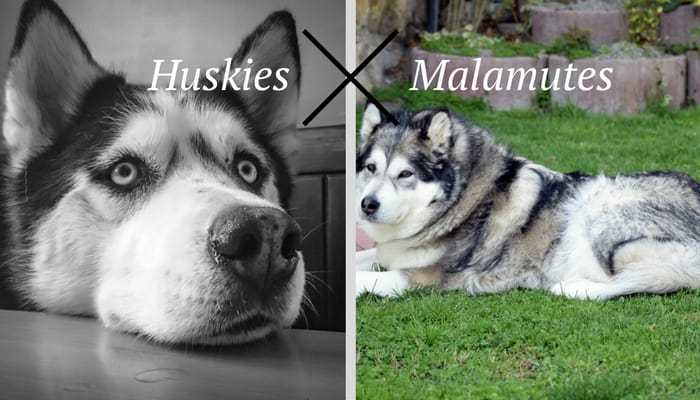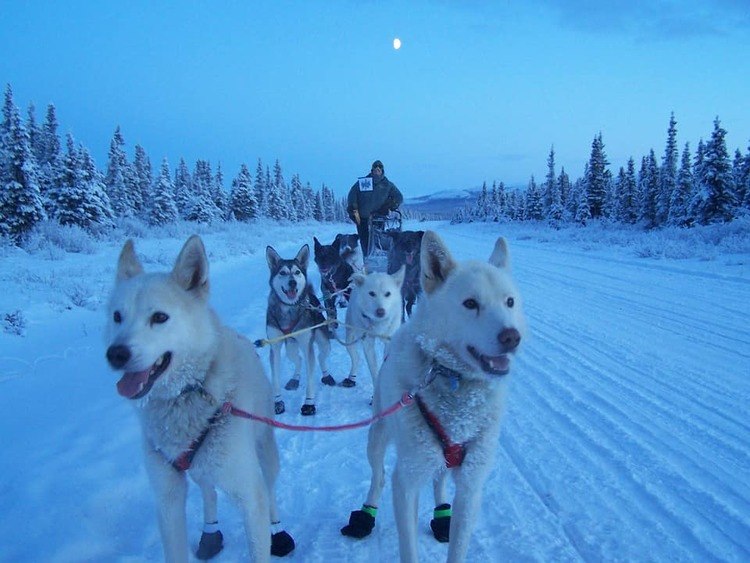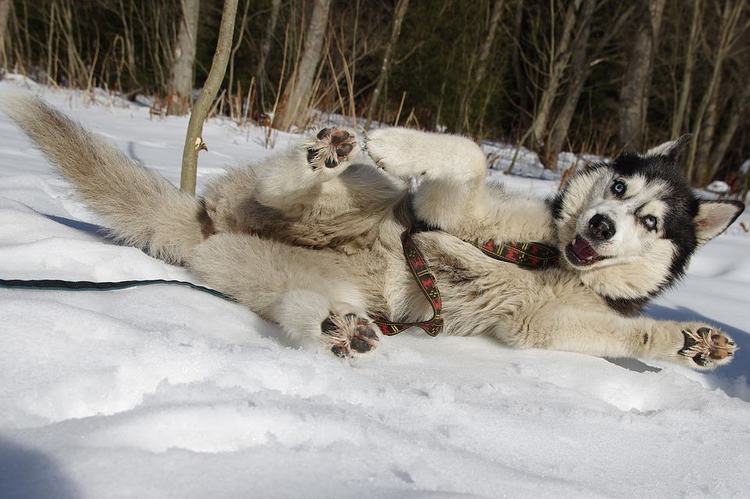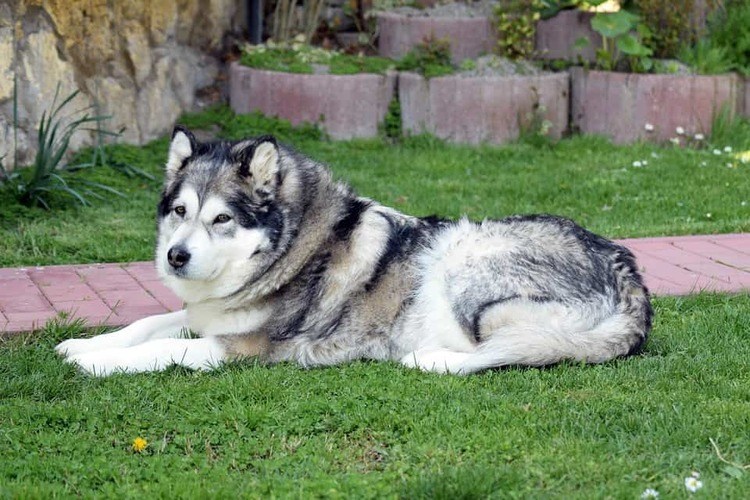These two breeds look almost identical to the untrained eye, so it can be pretty tricky to pick who is who in the battle between Alaskan Malamutes and Siberian Huskies.
However, there are significant differences between the two, and we’re going to reveal just how diverse (and how similar) these two breeds are.
Want to compare the Malamute vs Husky? Read on!
Alaskan Malamute vs Alaskan Husky

Let’s first start by throwing something extra into the mix – let’s take a quick look at the Alaskan Husky.
This name generally refers to a cross between a Siberian husky & Alaskan malamute.
These pups were primarily bred as working dogs, make very efficient sled dogs, and are in high demand for the sport as a result.
Like their Siberian relatives, they have tons of energy. They are also extremely intelligent and gentle dogs.
They are physically smaller and leaner than the Alaskan malamute, and their eye color and coat color vary.
They are not (yet!) officially recognized as a breed by the American Kennel Club.
Where Do Alaskan Malamutes and Siberian Huskies Come From?
Many questions may come to mind when you start wading through the differences and similarities between the malamute vs husky. For example, how closely related are malamutes and huskies to wolves?
Well, like other dog breeds, huskies are related to wolves. However, it is their unique personality traits that keep them separate from their wild relative counterparts.
There are significant differences in temperament between huskies and wolves, so despite their genetic similarities, many think of dogs and wolves as completely separate species.
The malamute has a very similar appearance to a wolf and is a more primitive dog breed. This may be due to historical inbreeding between working sled dogs and wolves in the past.
However, the wolf grows to be much taller, even though they weigh almost the same. When standing side by side, the wolf appears much leaner than a malamute.
Malamute vs Husky: How Are They Different?
Is a malamute a husky? They certainly look similar!
First things first — despite their similarities, a malamute is not a Siberian husky — they are two distinctly separate breeds. They originated in different countries.
The name malamute comes from the Mahlemut tribe of Eskimos in Alaska, who developed the native North American breed for hauling heavy loads. At the same time, the Siberian husky’s origins can be traced to Northern Siberia, where they were bred as a long-distance sled dog breed by the ancient Chukchi peoples.
Both breeds are recognized by the American Kennel Club and the Canadian Kennel Club.
How do they compare physically and in appearance?
Appearance Comparisons
Large and powerful, the Alaskan malamute is built for strength and endurance and can pull heavy loads for miles at slow speeds.
At around 80-100lbs and a minimum of 23″ at the shoulder, they are larger and heavier than their Siberian counterparts, who reach a maximum weight of around 70lbs.

Siberian huskies are ideally built for pulling lighter loads over short distances at faster speeds, as their angular, more lightweight frame demonstrates.
Both breeds have dense double coats to protect them from extreme temperatures.
The malamute’s coat is thicker and longer than that of a husky, and they have chunky, bear-like heads with slightly rounded ears as opposed to the narrower foxy or wolf-like appearance of the husky.
Malamutes should always have brown eyes, whereas the husky’s eyes can be blue or brown or anything in between. The coat of a Siberian husky can vary in color and pattern, but the breed standard for the malamute demands more uniform colors and markings.
Malamute paws are adapted to slow travel across snow, so they are much larger, compact, and rounded than the smaller, pointed paws of the quick-footed husky.
How is the tail of a husky different from the tail of a malamute? The husky carries its tail low and sloping like a wolf, whereas the malamute carries its tail proudly in the air.
See more: our guide to the ‘curly’ husky tail.
Behavior and Temperament Comparisons
Their easy-going, people-friendly personalities make malamutes ideal family dogs. They love children and being part of a family pack, and they will follow you everywhere.
A malamute’s energy levels are high compared to other breeds, but they are significantly more laid back than huskies. They can be a little stubborn at times and may need to be motivated to work.
That said, they do need to keep busy, and their intelligence and problem-solving ability mean that if they are unhappy (or bored) enough to want to escape, they will find a way to do it.

A more independent breed, huskies, are slightly less people-oriented, making them excellent and loving family pets. They are more sociable with other dogs than malamutes and get on nicely with their own kind and other breeds.
Like the malamute, they are sharp-witted, but in contrast to the malamute, they are hyper with almost boundless energy, and they will get bored if left alone for too long.
An unoccupied husky will find something to do – which could result in him becoming destructive in the home or leaping over the fence to freedom.
Neither malamutes nor huskies are particularly vocal, but they prefer to howl rather than bark when they are. They tend to howl when they are excited or when they are left alone.
Do huskies and malamutes make good guard dogs? Neither breed make particularly good guard dogs as they’re so friendly.
When it comes to their overall temperament, it can be affected by three factors: genetics, training, and socialization. Remember, these dogs are both considered working dogs.
So, they have a ton of energy and love to run around and play. While this may be good, it can also sometimes make them more difficult to train as well.
Other Husky vs Malamute Differences
As working dogs, both breeds have tons of energy and require a lot of exercise to benefit their brains and bodies.
Who Is Easier to Train?
Although Siberian huskies are the more independent of the two, they are easier to train and are usually very obedient. When it comes to training a malamute, you will find you need more patience and persistence.
Without a challenge, the malamute can become bored and express this through destructive chewing and chronic howling. They can also be somewhat predatory when around smaller pets. However, they are pack animals and love spending time with their family.
Huskies, on the other hand, have an instinct to run. So, if you have them outside and do not have a fenced-in area for them to run around and play, you definitely want to have them on a leash.
Who Has the Longer Life Expectancy?
Generally, a husky is known to live longer than a malamute, with an average life expectancy of 12-15 years rather than the 10-12 years of the Alaskan malamutes.
Female dogs also generally tend to live slightly longer than males in all dog breeds, including huskies. However, this isn’t always going to be the case.

Who Sheds More? Care and Grooming
Expect your husky or malamute to shed their heavy coat at least once a year (depending on the temperature where you live). Shedding takes about six weeks, but aside from the shedding period, the need for grooming is minimal.
Malamutes have a thick coat that may require daily brushing. When brushing your malamute, keep an eye out for any mats or hot spots. These are common with this dog breed but can cause problems if not taken care of. It is also recommended that you bathe your malamute every six to eight weeks.
Your husky can also benefit from brushing but on a weekly basis rather than a daily basis. Huskies are considered self-cleaning and only require a few baths per year.
Common Medical Ailments Each May Experience
No matter which dog breed you choose, you want to familiarize yourself with the more common ailments and medical issues they may face down the line.
Hip dysplasia and cataracts are fairly common genetic disorders in both breeds, and prospective owners should consider this.
When purchasing your malamute or husky, make sure only to go through a reputable breeder. When doing so, you will find that the dog was most likely already screened for genetic disorders or common chronic health issues.
Huskies are the dog breed that will most likely experience fewer health problems. However, since they are more prone to cataracts, you should make sure they have regular exams so they can be caught early on.
Malamutes are predisposed to more health conditions compared to huskies. Some of these conditions may include thrombopathia, chondrodysplasia, hypothyroidism, bleeding disorders, and day blindness.
What Is the Average Price of Each Dog Breed?
You will typically find malamute and Siberian husky puppies at different price points, with the costs being affected by several factors, including their lineage and gender. A husky that is show-quality will also prove to be much more expensive.
On average, you can find a malamute puppy for around $1000. On the other hand, Siberian husky puppies can cost anywhere between $800 and $2500. If you are looking for a superior-pedigree puppy from either of these dog breeds, you are looking at price tags in the thousands.
Keep in mind that the price can vary considerably. It is best to consult AKC.org when looking for breed prices and purchase locations.
Malamute vs Husky: Some Similarities
Now that we have seen a few of the more notable differences between the malamute and husky, let’s take a closer look at some of their similarities.
Both Love Running
The ultimate goal of any Siberian husky is to run. It has proven time and time again that running is the husky’s favorite pastime. The malamute shares this love of running but doesn’t have the same escape risk as the husky.
Think about it this way. A husky sees a gated or fenced-in yard as a challenge they need to conquer. They are intelligent dogs and will be looking for an escape whenever possible. The malamute, on the other hand, will stay close and will want to stay with its people.
Both Built for Sledding
Both the husky and malamute were built to survive harsh and cold climates, making them both share a love of sledding. Again, they are working dogs, and both can pull sleds with near-effortless movement.
Which Breed Is Best?
So – malamute or husky?
These breeds are both winners and have a lot to offer. Both are well adapted to family life, but both are also best suited to active owners who have the time to spend with them daily.
Whichever you choose, you can be sure that they will give you back as much – if not more – love, companionship, and fun than you give them.
And, if you ever wonder who would win in a malamute vs husky fight — check out this video!
In Summary
Here is a table that quickly runs through some of the more notable differences when it comes to the malamute vs husky debate.
| Alaskan Malamute | Siberian Husky | |
| Height and Size | 20-25 inches | 20-22 inches |
| Weight | 80-100 pounds | 35-70 pounds |
| Coat Type | Long, double coat | Medium length, double coat |
| Coat Color | Black, light gray, some shades of red | Red, black, gray, white, sable, and agouti |
| Life Expectancy | 10-12 years | 12-15 years |
| Temperament and Behavior | Playful, confident | Friendly, playful, independent |
| Purpose | Pull heavy sleds over long distances at a slow pace | Pull light sleds over a long distance at a fast pace |
| Energy Level | Needs daily exercise | High energy and needs both physical and mental stimulation |
| Other Notable Characteristics | Can be aggressive with same-sex dogsLikes to chew and digMore people-oriented | Friendly with other animalsEscape artistDoesn’t need as much human interaction |
So, which will you choose? In addition to running, both dog breeds love people and are relatively obedient dogs. Both breeds offer exceptional beauty and character. If you want a partner in crime that loves the outdoors and exercise as much as you do, then either of these dog breeds will prove to be the best choice.
